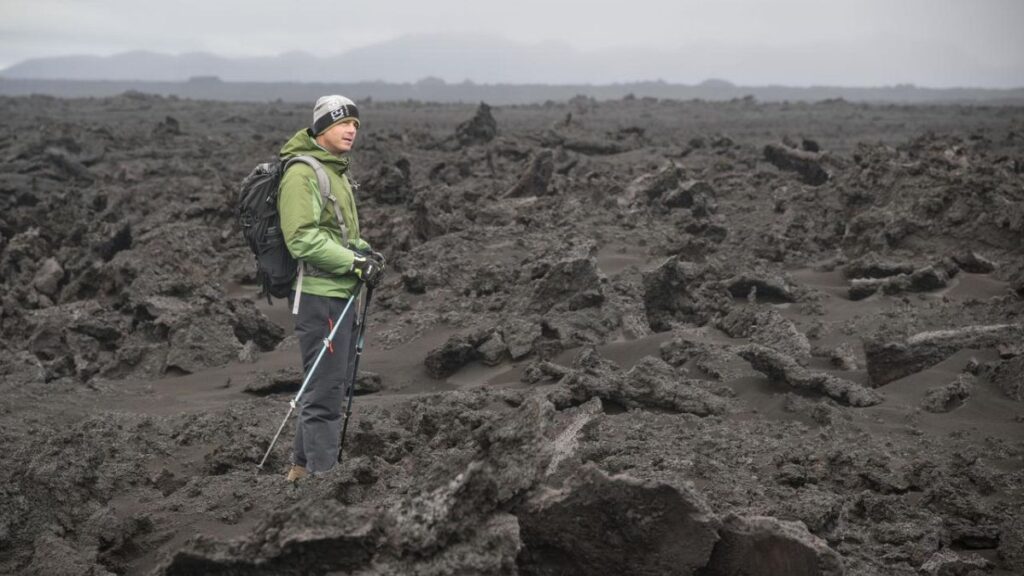The Artemis II crew of NASA and Canadian Space Agency (CSA) astronauts joined geologists on the Nordic island to collect samples of volcanic rock, practice their navigational skills, and identify sites for future training.
Before the end of the decade, the US agency is aiming to get a human crew on the surface of the Moon for the first time since the Apollo missions of the 1960s and 70s.
Iceland, the small island nation on the EU’s periphery, will play a key role in getting the astronauts ready – much in the same way it did back then.
From the Apollo missions to Artemis II, Iceland continues to help prepare the world’s astronauts for the Moon.
‘It’s like living in space’
The Moon, much like the Earth, has several different layers that form its surface.
The Moon has a metallic core protected by 1,350 km of thick lunar mantle made from a combination of cooled magma and dense minerals, like olivine and pyroxene, according toNASA, as well as roughly 50 km of lunar crust made of lighter minerals.
On the Moon’s surface are dark areas, named maria or seas in Latin by early astronomers. These hugeimpact basins, caused by meteor collisions, are made of basalt rock formed when magma flooded across the surface, cooling and hardening.
Vatnajökull National Park, which is about 15 per cent of Iceland’s total landmass, has a lot of the same features, like craters made from basalt rock or cooled magma, according to chief park ranger Helga Hvanndal Björnsdóttir.
“(The astronauts) always talk about the general feeling of this area, that it’s very lifeless and desolate,” she said. “It’s like living in space”.
Astronauts also find breccia in Iceland, which are angular fragments of rock that fuse together to form new rocks, NASA said.
To get to their training site, astronauts load their supplies onto off-road vehicles, taking a right turn on the main road outside the capital Reykjavik and driving for six hours to the park, according to Björnsdóttir.
The park is only accessible for three months of the year due to the long-lasting snow cover, Björnsdóttir added, so NASA’s training missions make up one part of the packed six-week peak research season.
“It’s very exciting to get a glimpse of those that are actually going up in space and hopefully going to advance our knowledge and understanding of the lunar environment,” she added.
But, Björnsdóttir said most Icelandic people and tourists have no idea that this kind of training is happening on the island.
A long tradition of picking the island
Iceland has been used for astronauts since the 1960s, according to a press release from NASA.
Orlygur Hnefill Örlygsson founded Iceland’s Exploration Museum in Húsavík, a small town of 2,400 people on the outskirts of the park, to preserve this little-known part of the country’s history.
Most of the original astronauts NASAselected in 1963 for the Apollo missions were military servicemen or civilians, who Örlygsson said struggled to stay interested in their geology lessons.
“They would fall asleep in their classes,” Örlygsson said. “NASA realised they would have to do something more interesting”.
A NASA scientist suggested a field trip to Iceland, Örlygsson said, and the rest is history.
Two field trips in 1965 and 1967 brought over 30 astronauts to take rock samples around Lake Mývatn and Askja, the volcanic area of Vatnajökull National Park, he continued.
During their field trips, astronauts learned how to identify the chemical composition of the different rocks they would find on the Moon’s surface, Örlygsson said.
Trevor Graff, exploration geologist and the hardware and testing lead on the Artemis science team at NASA’s Johnson Space Center in Houston, said in apress release that today’s astronauts use the same tools and techniques in Iceland as those from the Apollo missions.
“Traditionally, a geologist goes out with just standard tool sets of things like rock hammers and scoops or shovels to sample the world around them, both on the surface and subsurface,” Graff said.
Artemis II to launch in 2025 after delays
The astronauts that went to Iceland this summer are training for Artemis II: one small step towards NASA’s long-time goal to put humans back on the surface of the Moon.
Four astronauts will spend 10 days in orbit and travel roughly 7,400 kilometres beyond the far side of the Moon.
They will be getting there in a new NASA spacecraft, called Orion, which will eventually see humans return to the surface of the Moon on a future Artemis III mission.
Even though the Artemis II astronauts will not be landing on the Moon, NASA said their training in Iceland “will be critical” for their scientific studies, like studying the Moon’s craters from orbit, according to a pressrelease.
The upcoming mission will also “pave the way to land the first woman, first person of colour, and first international partner astronaut on the Moon,” NASA said.
Artemis II is scheduled tolaunch in September 2025. Artemis III, its sister mission which will aim to land astronauts near the lunar South Pole, is still on track for 2026.
NASA postponed both missions by roughly a year in January because part of the Orion capsule’s heat shield eroded in re-entry during the Artemis I launch in 2022, according to a report from NASA’s inspectorgeneral.
Source link : http://www.bing.com/news/apiclick.aspx?ref=FexRss&aid=&tid=67062ad454d344bab8ff8720002522e5&url=https%3A%2F%2Fwww.euronews.com%2Fmy-europe%2F2024%2F10%2F09%2Ffrom-apollo-to-artemis-icelands-little-known-history-of-hosting-nasas-moon-training-missio&c=8944980418532139762&mkt=de-de
Author :
Publish date : 2024-10-08 21:01:00
Copyright for syndicated content belongs to the linked Source.
